
The Gweagal (also spelt Gwiyagal) are a clan of the Dharawal people of Aboriginal Australians. [1] [2] [lower-alpha 1] Their descendants are traditional custodians of the southern areas of Sydney, New South Wales, Australia.

The Gweagal (also spelt Gwiyagal) are a clan of the Dharawal people of Aboriginal Australians. [1] [2] [lower-alpha 1] Their descendants are traditional custodians of the southern areas of Sydney, New South Wales, Australia.
The Gweagal lived on the area of the southern side of the Georges River and Botany Bay stretching towards the Kurnell Peninsula. [3] Their traditional lands, while not clearly defined, might have extended over much of the area from Cronulla to as far west as Liverpool. [1]

The Gweagal are the traditional owners of the white clay pits in their territory, which are considered sacred. Historically clay was used to line the base of their canoes so they could light fires, and also as a white body paint, (as witnessed by Captain James Cook). Colour was added to the clay using berries, which produced a brightly coloured paint that was used in ceremonies. It was also eaten as a medicine, an antacid. Geebungs and other local berries were mixed in the clay. [4]
Natural and modified caves or rock shelters were utilised by the Gweagal, including during walkabout – seasonally guided maintenance of land and the "natural gardens" tended by the Aboriginal people.[ citation needed ] A rock cave collapse at Port Hacking before 1770 claimed many lives of the Gweagal. This cave was later dynamited, revealing many skeletons.[ citation needed ] In the Royal National Park some of the caves were used as burial sites. In tribal lands[ further explanation needed ] and Dreamtime places this cultural practice continues.
There is a large cave located in Peakhurst with its ceiling blackened from smoke. There are caves located around Evatt Park, Lugarno with oyster shells ground into the cave floor. A cave has also been discovered near a Baptist church in Lugarno, and another near Margaret Crescent, Lugarno (now destroyed by development), which was found to contain ochre and a spearhead on the floor of the cave when it was excavated. Another cave exists on Mickey's Point, Padstow, which was named after a local Gweagal man. [5]
The Gweagal decorated their caves and homes with carvings, sculpture, beads, paintings, drawings and etchings using white, red and other coloured earth, clay or charcoal. Symbols such as "water well" with a red ochre hand directed newcomers to wells and water storage. Footprints on a line signalled that there were stairs or steps in the area. The dwellings had thermal mass which help to keep an even temperature year-round. Rugs, furs and woven mats provided further warmth and comfort. Fire was used to cook, produce materials and keep their shelters warm.[ citation needed ]
The territory of the Gweagal had much to offer. The Georges River provided fish and oysters. Various small creeks, most of which are now covered drains, provided fresh water. Men and women fished in canoes or from the shore using barbed spears and fishing lines with hooks that were crafted from crescent-shaped pieces of shell. Waterfowl could be caught in the swamplands near Towra Point and the variety of soils supported a variety of edible and medicinal plants. Birds and their eggs, possums, wallabies and goannas were also a part of their staple diet. The abundant food source meant that these natives were less nomadic than those of Outback Australia.[ citation needed ]
Middens have been found all the way along tidal sections of the Georges River where shells, fish bones, and other waste products have been thrown into heaps. These, as well as environmental modifications such as dams, building foundations, large earthen excavations and wells, gives evidence of where the Gweagal established villages for long periods, and are found where oysters, fresh water, and strategic views come together. Middens have been found in Oatley, and Oatley Point was known as a feasting ground. In Lugarno a midden is still existent and may be found in Lime Kiln Bay.[ citation needed ]
The Gweagal first made visual contact with Cook and other Europeans on the 29 April 1770 in the area which is now known as "Captain Cook's Landing Place", in the Kurnell area of Kamay Botany Bay National Park. [6] It was the first attempt made, on Cook's first voyage, in the Endeavour, to make contact with the Aboriginal people of Australia. [7]
In sailing into the bay they had noted two Gweagal men posted on the rocks, brandishing spears and fighting sticks, and a group of four too intent on fishing to pay much attention to the ship's passage. Using a telescope as they lay offshore, approximately a kilometre from an encampment consisting of 6–8 gunyahs, Joseph Banks recorded observing an elderly woman come out of the bush, with at first three children in tow, then another three, and light a fire. While busying herself, she looked at the ship at anchor without showing any perplexity. She was joined by the four fishermen, who brought their catch to be cooked. [7]
When Cook and crew made their first landfall two Gweagal men came down to the boat to fend off what they thought to be spirits of the dead. They shouted "Warra warra wai," meaning "You are all dead," and gestured with their spears. [8] Cook's party attempted to communicate their desire for water and threw gifts of beads and nails ashore. The two Aboriginal men continued to oppose the landing and Cook fired a warning shot. One of the Gweagal men responded by throwing a rock, and Cook fired on them with small shot, wounding one of them in the leg. [9] The crew then landed, and the Gweagal men threw two spears before Cook fired another round of small shot and they retreated. The landing party found several children in nearby huts, and left some beads and other gifts with them. The landing party collected 40 to 50 spears and other artefacts. [10] [11] [12]
Cook and his crew stayed at Botany Bay for a week, collecting water, timber, fodder and botanical specimens and exploring the surrounding area. The Indigenous inhabitants observed the Europeans closely but generally retreated whenever they approached. Cook's party made several attempts to establish relations with the Indigenous people, but they showed no interest in the food and gifts the Europeans offered, and occasionally threw spears as an apparent warning. [13] [b] [14]
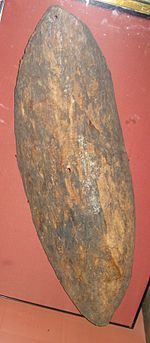
In 1770, after returning to England from their voyage in the South Pacific, Cook and Banks brought with them a large collection of flora and fauna, along with cultural artefacts from their most recent venture. The find included a collection of roughly fifty Aboriginal spears that belonged to the Gweagal people. Banks was convinced the spears were abandoned (on the shores of Kurnell) and "thought it no improper measure to take with them all the lances which they could find, somewhere between 40 or 50". [15]
According to Peter Turbet, four of these spears still exist: two bone-tipped three-pronged spears (mooting), one bone-tipped four-pronged spear (calarr) and a shaft with a single hardwood head – the only material reminder of this first contact. [16] Cook gave the spears to his patron, John Montagu, First Lord of the Admiralty and Fourth Earl of Sandwich, who then gave them, to his alma mater Trinity College at the University of Cambridge in England. Archaeologists quote them as being priceless, as the spears are among the few remaining artefacts that can be traced back to Cook's first voyage. Although the Gweagal Spears remain in the ownership of Trinity College, they are now on display at the Museum of Archaeology and Anthropology at the University of Cambridge. [17] [18]

An Aboriginal shield held by the British Museum had until 2018 been described by the Museum as most likely the bark shield dropped by an Aboriginal warrior who was shot in the leg by Cook's landing party on 29 April 1770. [19] The shield was lent to the National Museum of Australia in Canberra for an exhibition called Encounters: Revealing stories of Aboriginal and Torres Strait Islander objects from the British Museum, from November 2015 to March 2016. [20] [21] Rodney Kelly, sixth-generation descendant of Gweagal man Cooman, went to see the exhibition and immediately started a campaign for the return of the shield, along with the spears in held in Cambridge. Regarded as stolen objects of cultural significance, Kelly said that "the shield is the most significant and potent symbol of imperial aggression – and subsequent Indigenous self-protection and resistance – in existence". [22]
In April 2016, the British Museum offered to display the shield in Australia on a loan, but its permanent return was the only acceptable outcome for the Gweagal people. In 2016 the NSW Legislative Council and the Australian Senate passed motions supporting Kelly's claims. [18] Kelly made several crowdfunded trips to the UK, and included a trip to Germany in 2016. [22] [23] On this trip, Kelly discovered that the Ethnological Museum of Berlin holds another shield also said to be connected to Cook's 1770 visit to Botany Bay. [24]
In November 2016, the British Museum began investigating the provenance of the shield held by them. They held a workshop involving various experts, including curators from both the British and Australian Museums, academics from the Royal Armouries, Cambridge and the Australian National University, and two Aboriginal representatives from La Perouse (the location of Cook's landing site). The participants examined the species of wood, other shields held by the British Museum, museum records and catalogue, and old colonial shipping records. The results of the workshop were reported by Maria Nugent and Gaye Sculthorpe, an Aboriginal curator at the museum, and published in Australian Historical Studies in 2018. The study discussed the origin of the shield, concluding that its history may never be completely settled. [lower-alpha 2] Nicholas Thomas, director and curator of the Museum of Archaeology and Anthropology at Cambridge, [25] in his article in the same issue of AHS, also examined the provenance of the shield, concluding that it is not the shield taken from Botany Bay in April 1770. [18] [19] [26] Testing of the shield found that its wood is red mangrove, which can only be obtained at least 400 kilometres (250 mi) north of Botany Bay. The hole in the shield was "inspected by a firearms specialist and examined for traces of lead", with the conclusion that it was not caused by a bullet. [27]
Historian and archivist Mike Jones of the eScholarship Research Centre of the University of Melbourne and ANU School of History, [28] while not disputing the outcome of the workshop or Thomas' claim, has challenged the use of purely European sources and perspectives to provide the provenance Indigenous artefacts, saying that the shield has become a "cultural touchstone". [29] Sarah Keenan, Leverhulme Fellow and senior lecturer at Birkbeck College Law School in London, [30] said that Indigenous perspectives and methodologies were not used in the workshop, and a different conclusion may have been reached, or other knowledge gained about its significance, had such methods been applied. [19] Thomas himself said that the fact that the shield is not the one represented in the story of the Gweagal Shield does not mean that it should not be repatriated, and its symbolism to all Indigenous Australians should not lose its power. [31] The discussion around the shield is part of a growing movement for the decolonisation of museums in the UK [32] and around the world. [33]
Three of the spears were sent from Cambridge to the National Museum of Australia for the exhibition entitled Endeavour Voyage: The Untold Stories of Cook and the First Australians, [34] from 2 June 2020 to 26 April 2021. [35] The La Perouse Local Aboriginal Land Council and La Perouse Aboriginal Community Alliance worked with the Cambridge museum towards repatriation of the three spears, and on 30 April 2021 it was announced that plans had been made to return the spears to Country. [34] On 23 April 2024, the spears were repatriated to the Gweagal people by the University of Cambridge. [36]
{{cite book}}: CS1 maint: location missing publisher (link)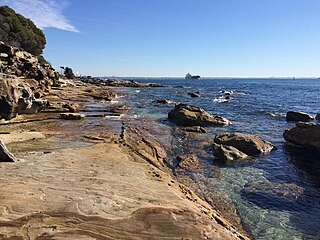
The Kamay Botany Bay National Park is a heritage-listed protected national park that is located in the eastern part of Botany Bay in Sydney, New South Wales, Australia. The 456-hectare (1,130-acre) national park is situated approximately 16 kilometres (9.9 mi) south-east of the Sydney central business district, on the northern and southern headlands of Botany Bay. The northern headland is at La Perouse and the southern headland is at Kurnell.
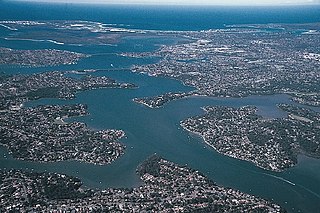
The Georges River, also known as Tucoerah River, is an intermediate tide-dominated drowned valley estuary, that is located in Sydney in the state of New South Wales, Australia. The Georges River is located south and south-west from the Sydney CBD, with the mouth of the river being at Botany Bay.
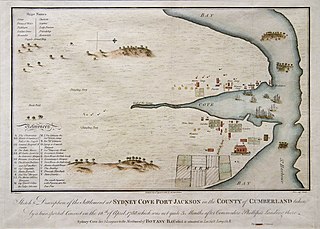
Sydney Cove is a bay on the southern shore of Sydney Harbour, one of several harbours in Port Jackson, on the coast of Sydney, New South Wales. Sydney Cove is a focal point for community celebrations, due to its central Sydney location between the Sydney Opera House and the Sydney Harbour Bridge.
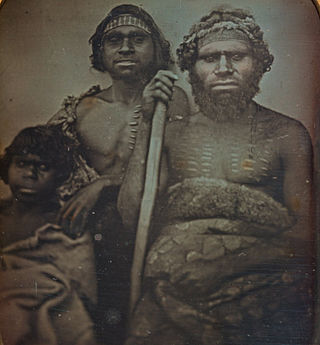
Koori is a demonym for Aboriginal Australians from a region that approximately corresponds to southern New South Wales and Victoria. The word derives from the Indigenous language Awabakal. For some people and groups, it has been described as a reclaiming of Indigenous language and culture, as opposed to relying on European titles such as "Aboriginal". The term is also used with reference to institutions involving Koori communities and individuals, such as the Koori Court, Koori Radio and Koori Knockout.

The Eora are an Aboriginal Australian people of New South Wales. Eora is the name given by the earliest European settlers to a group of Aboriginal people belonging to the clans along the coastal area of what is now known as the Sydney basin, in New South Wales, Australia. The Eora share a language with the Darug people, whose traditional lands lie further inland, to the west of the Eora.

Botany Bay is an open oceanic embayment, located in Sydney, New South Wales, Australia, 13 km (8 mi) south of the Sydney central business district. Its source is the confluence of the Georges River at Taren Point and San Souci as well as the Cooks River at Kyeemagh, which flows 10 km (6 mi) to the east before meeting its mouth at the Tasman Sea, midpoint between the suburbs of La Perouse and Kurnell. The northern headland of the entrance to the bay from the Tasman Sea is Cape Banks and, on the southern side, the outer headland is Cape Solander and the inner headland is Sutherland Point.

A scarred tree or scar tree, also known as a canoe tree and shield tree, is a tree which has had bark removed by Aboriginal Australians for the creation of bark canoes, shelters, weapons such as shields, tools, traps, containers or other artefacts. Carved trees are created as a form of artistic and spiritual expression by some Aboriginal peoples, to mark sites of significance such as burial sites.

Australian Aboriginal artefacts include a variety of cultural artefacts used by Aboriginal Australians. Most Aboriginal artefacts were multi-purpose and could be used for a variety of different occupations. Spears, clubs, boomerangs and shields were used generally as weapons for hunting and in warfare. Watercraft technology artefacts in the form of dugout and bark canoes were used for transport and for fishing. Stone artefacts include cutting tools and grinding stones to hunt and make food. Coolamons and carriers such as dillybags, allowed Aboriginal peoples to carry water, food and cradle babies. Message sticks were used for communication, and ornamental artefacts for decorative and ceremonial purposes. Aboriginal children’s toys were used to both entertain and educate.

The Dharug language, also spelt Darug, Dharuk, and other variants, and also known as the Sydney language, Gadigal language, is an Australian Aboriginal language of the Yuin–Kuric group that was traditionally spoken in the region of Sydney, New South Wales, until it became extinct due to effects of colonisation. It is the traditional language of the Dharug people. The Dharug population has greatly diminished since the onset of colonisation. Eora language has sometimes been used to distinguish a coastal dialect from hinterland dialects, but there is no evidence that Aboriginal peoples ever used this term, which simply means "people". Some effort has been put into reviving a reconstructed form of the language.

The Tharawal people and other variants, are an Aboriginal Australian people, identified by the Yuin language. Traditionally, they lived as hunter–fisher–gatherers in family groups or clans with ties of kinship, scattered along the coastal area of what is now the Sydney basin in New South Wales.

The Bidjigal people are an Aboriginal Australian people whose traditional lands are modern-day western, north-western, south-eastern, and southern Sydney, in New South Wales, Australia. The land includes the Bidjigal Reserve, Salt Pan Creek and the Georges River. They are part of the Dharug language group, and there is debate as to whether the clan is part of the Dharug or Eora people.

The Museum of Archaeology and Anthropology, also known as MAA, at the University of Cambridge houses the university's collections of local antiquities, together with archaeological and ethnographic artefacts from around the world. The museum is located on the university's Downing Site, on the corner of Downing Street and Tennis Court Road. In 2013 it reopened following a major refurbishment of the exhibition galleries, with a new public entrance directly on to Downing Street.
Nicholas Jeremy Thomas is an Australian-born anthropologist, Professor of Historical Anthropology, and Director, Museum of Archaeology and Anthropology, University of Cambridge since 2006, and Fellow of Trinity College, Cambridge since 2007.

Lugarno is a suburb situated in the St George area of southern Sydney, in the state of New South Wales, Australia. It is located in the local government area of the Georges River Council, 23 kilometres south of the Sydney central business district.
Arabanoo was an Aboriginal Australian man of the Eora forcibly abducted on New Year's Eve 1788 by the British military who arrived with the First Fleet at Port Jackson. His capture was organised to force communication and relations between the Aboriginal people and the British. Arabanoo was the first Aboriginal Australian to live among Europeans.

The Gweagal shield is an Aboriginal Australian shield dropped by a Gweagal warrior opposing James Cook's landing party at Botany Bay on 29 April 1770. The shield was recovered by Joseph Banks and taken back to England, but it is unclear whether the shield still exists. An Aboriginal shield held by the British Museum, and once thought to be the Gweagal shield, is more likely to originate from an area further north. It is currently the subject of a campaign for its repatriation to Australia.
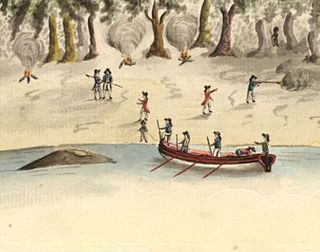
Willemering or Wileemarin was a man of the Eora people of Aboriginal Australians who on 7 September 1790 became a notable identity by spearing Arthur Phillip, the first governor of New South Wales.

Silver Beach is a 2.8 km (1.7 mi) long west-trending sand spit in Kurnell, Sydney, New South Wales, Australia that is located 18 km (11 mi) south of the Sydney CBD. Situated on the northwestern reaches of the Kurnell Peninsula and linked with the sandstone of Sutherland Point in the east, the beach is characterised by silver-coloured sands, hence the name, and fourteen rockwall groynes which project into Botany Bay.

Cooman was a Gweagal man identified by some of his descendants as the warrior who was shot and wounded by James Cook's landing party at Kamay in 1770. He was previously unnamed in historical documents, and his identity has been disputed within the local Aboriginal community. Little is known of Cooman's life apart from his possible involvement in this incident.

Gringerry Kibba Colebee also spelt Colebe, Coleby or Colbee, was an eighteenth-century Gadigal man, an Aboriginal Australian people from present-day Sydney, New South Wales.